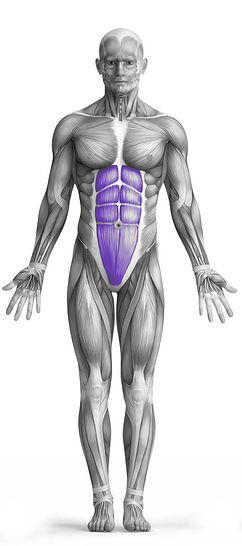Standing Cable Crunch 101 Video Tutorial
0

Exercise Synopsis
Target Muscle Group
Abs
Secondary Targets
None
Execution
Isolation
Force Type
Pull
Required Equipment
Cable Machine
Fitness Level
Beginner
Variations
None
Alternatives
None
Timer
Hour
Minute
Second
Stopwatch
00:00:00:00
Overview
The "Standing Cable Crunch" is an effective core exercise that primarily targets the abdominal muscles, helping to strengthen and tone the abs. Performed using a cable machine, this exercise involves standing with the cable attachment positioned above the head, holding the handle with both hands. By engaging the core, you pull the cable downward, bringing your elbows toward your knees in a controlled motion. This exercise isolates the abs, promoting muscle growth and endurance without requiring additional secondary muscle engagement. It is essential to maintain proper form and avoid using momentum to maximize effectiveness and reduce the risk of injury.
How to Perform
Begin by attaching a rope handle to the high pulley of a cable machine. Position yourself facing away from the machine with your feet set shoulder-width apart.
Grasp the rope handle with both hands, bringing it down to each side of your head, keeping your arms slightly bent.
Take a small step forward to create tension in the cable. Bend your knees slightly and tighten your core muscles to prepare for the movement. This is your starting stance.
Initiate the movement by pulling the rope downward toward your knees. As you do this, contract your torso forward, focusing on leading the motion with your elbows while keeping your hips stable.
Keep the movement controlled and use your abdominal muscles to power the crunch. Avoid using your hips or legs to generate momentum.
Slowly return to the starting position, maintaining constant tension in the cable and engaging your abs. This completes one repetition.
Continue performing the desired number of repetitions, ensuring proper form and steady engagement of your core throughout the set. Make sure not to rush the movement to maximize muscle activation and avoid unnecessary strain.
★ Bonus: For exercises that involve external weights (such as dumbbells, barbells, or machines), the One Rep Max (1RM) calculator can help you estimate your maximum lifting capacity. Use it to track your strength progress and adjust your training for optimal results.
Tips
Perform the movement in a slow and controlled manner. This ensures maximum activation of the abdominal muscles while minimizing the risk of injury.
Direct your attention to contracting your abs rather than pulling with your arms. The arms should simply assist in guiding the rope through the motion.
Keep your back neutral throughout the exercise. Avoid excessive arching, and ensure that the movement comes from your torso to protect your spine.
Do not rely on your hips or legs to help with the crunch. Focus solely on flexing your spine using your abdominal muscles to execute the movement effectively.
How Not to Perform
Avoid Using Momentum: Do not swing or jerk your body to initiate the movement. Keep the movement slow and controlled to avoid using momentum, which can reduce muscle activation and increase the risk of injury.
Don’t Pull with Your Arms: Avoid relying on your arms to pull the rope. The focus should be on your abs, so use your core to pull the rope down. The arms should only guide the movement, not drive it.
Don’t Arch Your Back: Keep your back in a neutral position. Excessive arching can strain your spine. Ensure the motion is coming from your torso rather than from your lower back.
Avoid Using Hips or Legs: Do not engage your hips or legs to assist with the crunch. The movement should be isolated to your abs. Using your hips or legs reduces the focus on the target muscle and wastes energy.
Don’t Rush the Reps: Avoid performing the exercise too quickly. Fast movements can decrease muscle engagement and lead to poor form. Slow, deliberate reps ensure your core is fully activated throughout the exercise.
Don’t Let the Tension Drop: Avoid letting the cable lose tension between reps. Keep consistent tension on the cable to maintain activation in your abs and maximize the effectiveness of the exercise.
Don’t Overextend the Motion: Avoid going too far in either direction. Overextending on the way back can reduce the tension on your abs, and overexerting during the crunch can cause unnecessary strain. Keep the movement within a controlled range of motion.
Avoid Holding Your Breath: Do not hold your breath during the exercise. Keep a steady breathing pattern—exhale as you crunch down and inhale as you return to the starting position. Proper breathing helps maintain stability and control throughout the movement.
Variations
Variations of fitness exercises refer to different ways of performing a specific exercise or movement to target various muscle groups, intensities, or goals. These variations aim to challenge the body differently, prevent plateaus, and cater to individuals with varying fitness levels.
Alternatives
Alternative exercises in fitness refer to different movements or activities that target similar muscle groups or serve the same training purpose as the primary exercise. These alternative exercises can be used as substitutes when the original exercise is unavailable or challenging to perform due to various reasons such as equipment limitations, injuries, or personal preferences.








